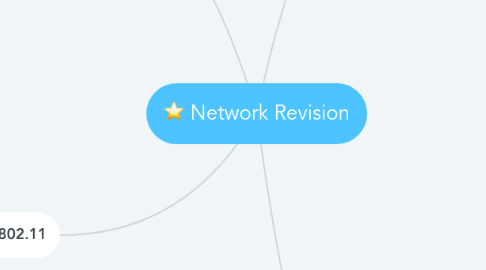
1. Cabling types
1.1. Fiber Optic cable
1.1.1. An optical fiber cable, also known as a fiber optic cable, is an assembly similar to an electrical cable, but containing one or more optical fibers that are used to carry light. The optical fiber elements are typically individually coated with plastic layers and contained in a protective tube suitable for the environment where the cable will be deployed. Different types of cable[1] are used for different applications, for example long distance telecommunication, or providing a high-speed data connection between different parts of a building.
1.2. Unshielded twisted pair (UTP)
1.2.1. Unshielded twisted pair (UTP) cables are found in many Ethernet networks and telephone systems. For indoor telephone applications, UTP is often grouped into sets of 25 pairs according to a standard 25-pair color code originally developed by AT&T Corporation. A typical subset of these colors (white/blue, blue/white, white/orange, orange/white) shows up in most UTP cables. The cables are typically made with copper wires measured at 22 or 24 American Wire Gauge (AWG),[4] with the colored insulation typically made from an insulator such as polyethylene or FEP and the total package covered in a polyethylene jacket.
1.3. Shielded twisted pair (STP)
1.4. Coaxial cable
2. 802.11
3. TCP Models
3.1. There are 4 TCP layers;
3.2. Datalink
3.2.1. The data link layer is the protocol layer in a program that handles the moving of data into and out of a physical link in a network.
3.3. Transport
3.3.1. TCP Transport layer is responsible for establishing temporary communication sessions between two application programs, and delivering data as requested by those applications. (When you make a phone call, a temporary session is established between you and the person you are calling).
3.3.2. The best-known transport protocol of TCP/IP is the Transmission Control Protocol (TCP), and lent its name to the title of the entire suite. It is used for connection-oriented transmissions, whereas the connectionless User Datagram Protocol (UDP) is used for simpler messaging transmissions. TCP is the more complex protocol, due to its stateful design incorporating reliable transmission and data stream services. Other protocols in this group are the Datagram Congestion Control Protocol (DCCP) and the Stream Control Transmission Protocol (SCTP).
3.4. Internet
3.4.1. This is the layer that contains the packet construct that will be transmitted. This takes the form of the Internet Protocol (IP) which describes a packet that contains a source IP Address, destination IP Address and the actual data to be delivered.
3.5. Application
3.5.1. The application layer is concerned with providing network services to applications. There are many application network processes and protocols that work at this layer, including HyperText Transfer Protocol (HTTP), Simple Mail Transport Protocol (SMTP) and File Transfer Protocol (FTP).
4. OSI Models
4.1. There are 7 OSI layers;
4.2. Application (Layer 7)
4.2.1. The Application layer supplies network services to end-user applications. Network services are typically protocols that work with user's data.
4.3. Presentation (Layer 6)
4.3.1. The Presentation layer is the simplest in function of any piece of the OSI model. At Layer 6, it handles syntax processing of message data such as format conversions and encryption / decryption needed to support the Application layer above it.
4.4. Session (Layer 5)
4.4.1. The Session Layer manages the sequence and flow of events that initiate and tear down network connections.
4.5. Transport (Layer 4)
4.5.1. The Transport Layer delivers data across network connections. TCP is the most common example of a Transport Layer 4 network protocol.
4.6. Network (Layer 3)
4.6.1. The Network layer adds the concept of routing above the Data Link layer. When data arrives at the Network layer, the source and destination addresses contained inside each frame are examined to determine if the data has reached its final destination.
4.7. Data link (Layer 2)
4.7.1. When obtaining data from the Physical layer, the Data Link layer checks for physical transmission errors and packages bits into data "frames". The Data Link layer also manages physical addressing schemes such as MAC addresses for Ethernet networks, controlling access of any various network devices to the physical medium.
4.8. Physical (Layer 1)
4.8.1. Physical layer of the OSI model is responsible for ultimate transmission of digital data bits from the Physical layer of the sending (source) device over network communications media to the Physical layer of the receiving (destination) device.
